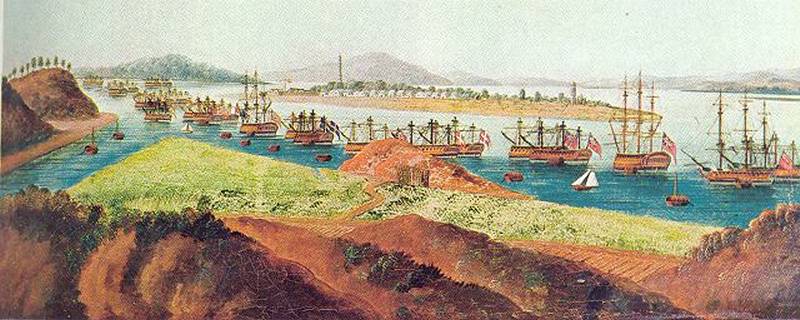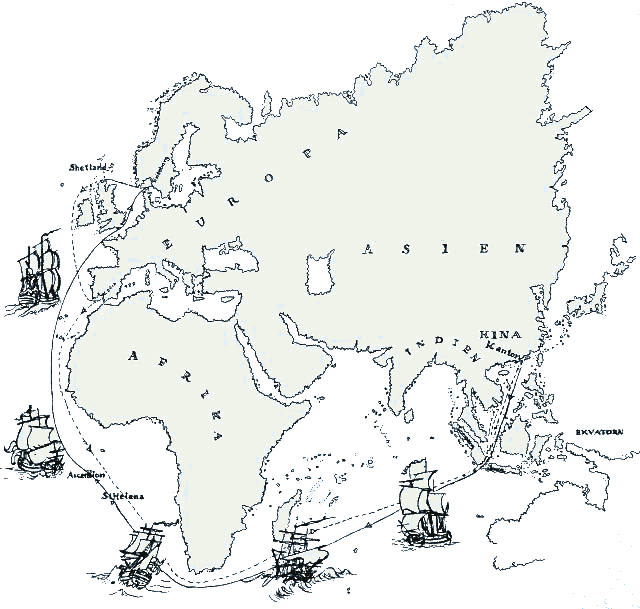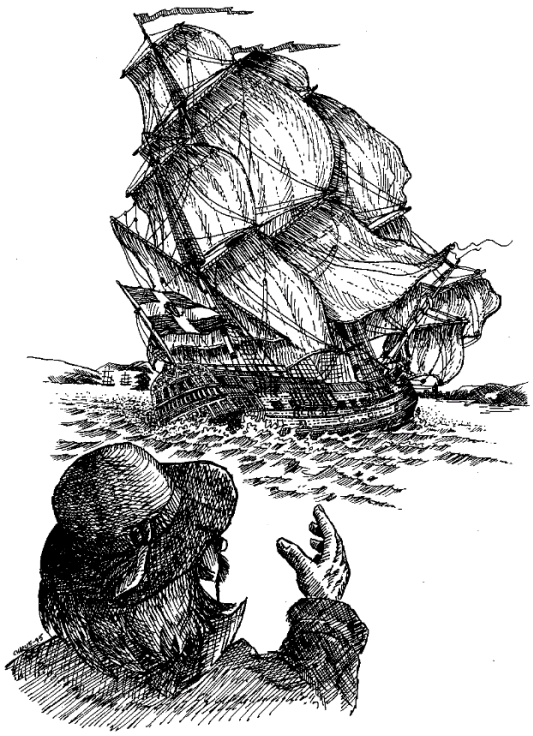


The final voyage of the Götheborg Ship was her third.
The Götheborg made up the eleventh expedition of the Swedish East India Company together with one more ship, the Riddarhuset. They would make the full journey back and forth with one major difference. The Riddarhuset would make it safely all the way back and unload in good order.
The Götheborg I was built on the shipyard Terra Nova in Stockholm and had a cargo capacity of 340 läster, or 843 metric tons.
She did her first voyage during the 7th expedition 1739-40 and was then auctioned to the 9th expedition for 84,000 Daler Silvermynt. The method of auctioning off all assets to the next expedition, made it possible to find out the true profit of each expedition.
Here are all ships that went out from the start until 1745.

In the early 1740s the East India Company main office in the city of Gothenburg was not yet built. More or less behind the back of the artist drawing this picture, is the then used warehouse probably more or less in Dutch style, built with its short end against the City harbor canal. Most probably some of the crew should have been lodged in this area. The smoke from the many chimneys blends with the pungent smell of barnyard. In the central harbor and the channels laundry is washed. From the backyards pigs, ducks, hens and some occasional cows are heard. The breeze from the nearby sea hardly helps.

The walk continues up and over the King's Height, down to and through the Carl's Gate, out from the city, over the bridges that connects the city with the current Iron Square and further west towards Masthugget. It is muddy. The well trodden roads are not much helped by the drizzling rain.
More than 260 years ago, in March 1743 the first East Indiaman with the name of Götheborg was resting safe and snug in a protected bay in the Western Swedish archipelago called Vargö Håla, right next to the islands of Styrsö where I sit and write these words right now. Right now outside of my window it is also mid December. And this is actually when the ship should have been here awaiting departure. Now the departure was delayed until March, which was a delay they never caught up with and might have been the ultimate cause of the problems along the way and the disaster two and a half year later.
It is now less than 3 years remaining of the East India Company's first royal charter. Just a few years later, the 14th July 1746, a new group of businessmen will be offered this incredible profitability monopoly on the Swedish East India trade. This is the most important future question for the directors of the company. The trade profit from any successful expedition are enormous.
These were the Directors of the Swedish East India Company's in 1743:
The preparations took much longer than usual and not before Monday, 17th March 1743 the winds were favorable enough to make it out through the narrow passage between Styrsö Tången and Vargö.
Soon Captain Moreen would give the order to hoist the anchor. Eventually she would set sail. The destination was Canton in China, and for two and a half year nobody would hear anything from her.
This late departure would prove to be impossible to catch in and were the first steps towards the disaster that were to come, a full 30 months later.
"Left same winter, 1742-43, with the ship Götheborg, but did not make it to Canton and had to stay over at the island of Java for 5 months, lacking food and water before we made it to land.
Suffered much for storms, lighting's and thunder and a frightening heat. There we lost 35 men in the strong heat, where we were daily surrounded by a horde of crocodiles.
Came happily to Canton and home, 1745. At home coming, we struck on a rock where both myself and many officers lost our cargo."
From: En sann och uppriktig levernesbeskrivning och personal by, Matts Holm (Mattias, Holmers), Quarter Master at the East Indiaman Götheborg. MS (Unpublished), SH511. Museum of Maritime History, Stockholm.
The course was made north of Scotland and they went first to Cadiz where they needed to add to their provisions and fetch the necessary silver, which the Chinese wished as payment for their merchandise. Only onboard the Götheborg, was taken in more than 5 tons of silver. The Riddarhuset who departed 10 days later and had chosen the route through the English Channel fetched their silver in a place called Ostende
Götheborg arrived at Cadiz the 7th April 1743 and stayed there for a full month. They took onboard provisions and silver and wines and a medical chest / chest of medicines which were to be passed on to Riddarhuset. August Tabeauteu also brought onboard a mason and had him make an oven. It was not until the 6th of May 1743 that they continued their voyage.
All until 1758, Cape was actually avoided for fear of military violence due to business competition with the Dutch.
Next stop was Java where they had fresh fruit, which they knew was a definite cure for scurvy, a disease that made the gums swell and eating of salty food painful. By then the men also craved something sugary and sweet but the access to so much fruit was not entirely risk free, "The vast amount of fruits eaten caused a marrow sucking bowl movement that threatened to take with it both cheek bones and stomach" (Wallenberg, 1769)

At Java the ships were approached by small boats, prahas, with Javanese wanting to sell fruits and fresh foods and all kinds of souvenirs, monkeys, birds etc.
Illustration from the diary of Gethe.
Götheborg rounds Cape and arrives at Java on 28 August 1743. The crew were in very poor condition. The late departure is now taking its toll. The combined period without vitamin C was too long but they were not entirely sure what caused scurvy, they guessed that there was too much salt in the food and only access to fresh food and fresh fruits would provide a cure. They were not able to depart Java before the 12th September but by this, they have also sealed their fate. It could have been / it could have depended on these last few days in August whether the monsoon winds would've lasted all the way to China.
The Island of Sapatou was a well-known landmark when sailing to China, next to the coast of Vietnam. The name means, "shoe" and was referring to the outlines of the island when approaching.
The notes are incomplete and we don't really know for sure what their activities were here. We can assume however, in treacherous waters, strong heat and powerful upstream, in weak or contrary winds, perpetually needed to pull out and sink the anchor to use every ounce of wind and slowly work their way towards China.
By 4 October, they had however sighted the island of Sapatou. But this is also the point where they need to give up trying to reach China this season. Water and provision is almost out and the northerly monsoon has set in with full power. They turn around and by the end of October 1743, they are again back at Java.
By coincidence, the sailing back and forth in these waters put them in line of the Dutch pepper trade, which raised the suspicions of the Dutch. But the Swedes explained their situation and anchored up outside Batavia the 8th December 1743. Here they stayed 5 months until the 28th May, 1744 'where they lost 35 men in the strong heat' as described by Mattias Holmers.
According to some court documents these seems to say that 'it was necessary to go to Bengal to find wood for repairs' and that Peter Wiberg then borrowed money from Captain Moreen to purchase own merchandise. Besides this, no information is preserved. This small note suggests a long and complicated guess, which we until further needs to leave out from this story.
In the beginning of June 1744 the ship should by right have arrived at Canton, but not before the 8 September we know for sure that they have arrived. These consistent delays tells us they were facing some kind of problems. We know that a large part of the crew had died and we can guess that a further large number of the crew are sick. For one thing, a perpetual upkeep of the ship was a part of the traveling, and they could have had a problem being able to do this. Some kind of private business venture could also have been ongoing of which no conclusive notes have been left to us.

Halfway up towards Canton in the Pearl River the East Indiamen from all nations trading to China anchored up. The ships were tackled down and masts and all equipment was brought to land to big sheds "banks halls" built and rented on an nearby island. The officers in command immediately continued up to Canton in small boats to start buying in for the return cargo. The crew was kept busy with ship's upkeep and was only occasionally let up to Canton.
The voyage from Canton to Sweden wasn't less troublesome but the information we have is less. Exactly when the Götheborg left from Canton is unknown but we can assume they leave together with the Riddarhuset, which departed Canton 10 January 1745. It also appeared that they have mustered 35 new men for the crew since the provision they took onboard was counted for 135 men. We know that in Canton and Java were many Swedes in Dutch service that might have been grateful for an opportunity to return back to Sweden.
Within a month, they arrived at Niewe Bay, the watering place in Java to fill up and take in a fresh water supply that is to last the entire way home to Sweden
No information is known about the Götheborg. But from the Riddarhuset sailing at the same time, we know that their ship became very slow from having taken in too much fresh water in tubs in Java. Only the 18th May did they reach the Cape. Here they were hit by severe storms and sprang a leak where with difficulties, they reached the island of St. Helena 10 June 1745.
Riddarhuset catches up with the Götheborg. After slightly more than a week they continue to Ascension where they both arrived the 27 June 1745.

One place where one tried to stop over and find some fresh food to cure the scurvy was the Island of Ascension. Illustration by: Lars Gillis.
Here they take onboard a fresh supply of water and new provisions amongst other things, turtles. Ascension is slightly south of the equator, which was passed on the 5th July.
6th September, both Riddarhuset and Götheborg arrive at the harbor of Dover. After a long and trouble filled voyage, both ships were in serious need of repair and new provisions. They took onboard each a pilot for the remaining of the trip and against 80 British pounds of payment the pilots Ellin Paskill and John Earl were to show both ships back home to Gothenburg.
11th September, Norway's southernmost part is in sight.
The East Indiaman Götheborg, the pride of the Swedish East India Company, is approaching land. She was the Company's largest vessel and named in honor of the city of Gothenburg, which was also the Company's home port. The outermost islet Vinga is sighted. There they take onboard their pilot Casper Mattsson from Brännö for the last, last part of the voyage; into the Göta River and the Gothenburg home harbor.
She was now fully laden with tea, spices, silks and porcelain and on the point of completing her third successful voyage to Canton and back.
Then, for no apparent reason, she struck onto the well-known underwater reef, the Hunnebådan, just alongside the main navigation channel and a mere 900 meters from the fortress of Nya Elfsborg. The impact was violent. The whole of her bow was crushed upon the rock, where she lodged fast with her aft under water. No one appears to have lost his life, and by good fortune a start could be made at once to recover her cargo.

The foundering of the East Indiaman Götheborg in 1745, at Hunnebådan. Original artwork in support of the Excavation project 1983-92, frighteningly precise as we understand what happened, and even as regarding to how the rebuilt ship eventually came out.
Then, in the morning of the 12th of September 1745 she appeared against the horizon outside the home harbor of Gothenburg.
Joy and Glory - she's back!
The Fortress of Älvsborg was just a few hundred meters ahead when the most spectacular catastrophe during the history of the Swedish East India Company occurred.
With an ear shattering crash the East Indiaman Götheborg struck an underwater rock and sank just outside of the home harbor of Gothenburg.
Silk and tea for millions of $ was water soaked and destroyed. Under all of this in the deepest holds of the hull was the porcelain cargo of the Götheborg of about 100 metric tons, or about 300,000 pieces.

The salvaging of what could be salvaged from the immensely valuable cargo started immediately. On and off it continued for two centuries.
Neither that, any archive research nor the recent excavations by Anders Wästfelt in 1983 to 1992, where eight years was spent sifting through tons of mud, soggy tea and porcelain shards, have managed to cast any light on this disaster that thus remains a mystery.
Despite recent finds of long lost documents, the rumor remains that there were something terrible wrong with the whole thing.
So, lets recap what we know
A number of days after homecoming the East Indiaman's crew had probably dried up their clothes and, if following the traditions they would have rented a large house with many rooms where the whole crew as well as the directors and the officers could meet to celebrate their safe homecoming and have a whole evening of food and entertainment. By most standards those who had survived would by now have been rich men despite the loss of the ship.
The name of the pilot was Casper Mattsson and he lived on an nearby island. He was born in 1713 and was 32 years old when he sank the Götheborg. After the foundering he was imprisoned in the Fortress of New Älvsborg and a few days later, the 28th September, the elderly commander of the Gothenburg Fleet, Schoutbynachten Gyllenskepp, asks that the pilot should be brought to the old admiralty shipyard to be tried and sentenced 'for his crimes while piloting the East Indiaman Götheborg'.
What went down during this questioning we will never know since these papers as so many more are missing, but the pilot was obviously set free. At his old age we know he was part owner in a fishing team and also owned a twelfth of a farm called Brännö Sörgård. Maybe not much but a far cry from being sentence to death which would be the normal consequence of setting a ship on ground if you were a pilot.
Pilot worked for the admiralty. Those who had sworn the pilot's oath had a right to build a cottage on a rock next to the beach if nobody needed the rock. And you had the right to let a cow graze on the grass next to it, if nobody else needed the grass. You had the right to get paid and the right for a few days' food sent with you since you were outgoing, where you were to be stationed at the Vinga Lighthouse and it could take awhile for you to get back home, especially if there was a storm.
Incoming and outgoing ships were required to take a pilot and pay according to the draught or how deep the ship went. The pilots were also required to keep a lookout for incoming ships. So if the pilot didn't spot a ship or accidentally put it aground, they were required to pay for the damage or otherwise get punished. If the ship was totally lost, the pilot was sentenced to death.
The fee for the route from Vinga to Gothenburg was 16 öre per feet, and since Götheborg had a draught of 18 feet, so the pilot got paid 2.88 SEK. As far as we know the pilot lived and died peacefully at old age and he passed away 6 January 1783 at the age of 70 years 13 days.
A persistent rumor has followed this wreck, that she was put on that ground on purpose. This rumor has caused endless speculations but nobody has been able prove or disprove this. The purpose of this should have been to avoid taxation since the ship would have been heavily overloaded with private cargo.
We have step by step closed in on an explanation, but it still remains to be done to tell the full history of the last trip of the East Indiaman Götheborg.
Ever since the East Indiaman Götheborg ran aground on 12 September 1745, the shipwreck has been discussed in most homes of people related to the sea, maybe sometimes together with a small souvenir the sea has flushed up on the beach near the wreck site. For generations, it was a popular Sunday pleasure to 'go wrecking' along the beach and carry home baskets of finds washed up from the huge wreck, which solid oak ribs were still visible above the surface well into the 19th century.
The one thing everybody seemed to be in agreement on was that, there just had to be something wrong.